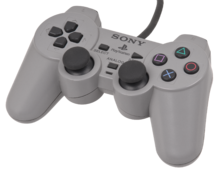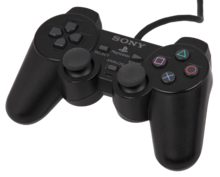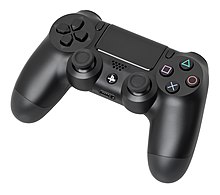DualShock
Dual Shock ( self-writing : DUAL HOCK or DUAL SHOCK ) is the name of which in the delivery gamepad the PlayStation and pre-term which in the delivery gamepad the PlayStation 2 , after the production of the setting SIXAXIS controller also of the PlayStation 3 and Playstation 4 . The DualShock controllers are products of the PlayStation brand , are distributed by Sony Interactive Entertainment and have two vibration motors, which are intended to supplement the visual impressions when playing video games . This feature was initially received with skepticism by some players, but ultimately convinced the majority with its novel feel.
Button layout
The DualShock controller has four main buttons (cross ( colloquial , but also properly called X or Plus), circle, square (or square) and triangle) that are arranged in a circular shape on the right side of the gamepad. According to Teiyu Goto, the designer of the first PlayStation controller, the cross stands for no, the circle for yes, the square for the menu and the triangle for the direction in which the player is looking. These buttons are assigned the main actions in most games. Side actions can usually be performed with the four shoulder buttons (L1, L2, R1, R2). The DualShock offers a 4-way control cross for direction control. Diagonal movements are possible by pressing two buttons at the same time. After Nintendo presented the N64 controller after long secrecy and thus introduced the joystick, Sony reacted to this idea and did the same for Nintendo; However, Sony installed two analog sticks that are controlled with the thumb. The L3 and R3 buttons can be reached by pressing the two analog sticks.
technology
Two vibration motors are used in the DualShock, hence the name DualShock. A small, somewhat louder motor, comparable to the one used in a pager or mobile phone , and a second somewhat more powerful motor, comparable to that in a Rumble Pak from Nintendo . These motors cause small metal weights to rotate, and the imbalance of these weights causes the controller to vibrate. The advantages of the DualShock over the Rumble Pak lie in the power supply, which in the Dualshock is secured by the PlayStation itself, in the Rumble Pak only by batteries .
The idea of a vibration function in a game controller was first brought to life by Nintendo in April 1997 (in Europe in October 1997) with the Rumble Pak , an add-on for the Nintendo 64 controller , which was integrated directly into the controller However, Nintendo only took over with the Nintendo GameCube controller in 2001.
Previous models
PlayStation controller
The PlayStation controller (model number: SCPH-1010) was a gamepad and the first controller of the PSX, released along with its release on December 3, 1994 in Japan. Particularly characteristic of the gamepad is the lack of the two analog sticks, which were only introduced with the dual analog controller in 1997.
Dual analog controller
The dual analog controller (European model number: SCPH-1180e) replaced the PlayStation gamepad when it was released in Japan on April 25, 1997. This controller introduced the two analog sticks. Because these could be operated simultaneously and posed a challenge for some consumers, Sony added an "Analog" button with an LED display in the middle between them, with which the analog sticks could be deactivated and the function of which would fall back on the directional pad if the game did allowed. This option remained until the DualShock 2. The dual analog controller looked very similar to its successor DualShock, only subtle differences existed, such as protruding edges on the upper edge of the L2, R2 buttons to distinguish them from L1, R1.
DualShock
The DualShock is the first controller of the DualShock controller series and was introduced in Japan on November 20, 1997 with the Gran Turismo game (in the USA and Europe in May 1998) as an optional accessory and shortly thereafter adopted as the standard for the PlayStation. It replaced the dual analog controller , which looks identical from the outside, but has only one vibration motor. The PlayStation's DualShock controller is the last to have its body gray by default, which is because the PlayStation is the only console in the PlayStation family that is gray.
DualShock 2
In the course of the release of the PlayStation 2, the improved, second version of the DualShock also came. The structure is completely the same. However, it now has larger shoulder buttons, two additional vibration levels and the buttons are now pressure sensitive, but this feature was only supported by a few games. The color of the case has been changed from gray to black to match the case of the PlayStation 2. The PlayStation 2's DualShock controller is the last controller in the PlayStation family to be connected to the console with a cable. All of the following are wirelessly connected to the console via Bluetooth , but can also be connected using a mini USB cable supplied to reduce the input delay (latency) and to prevent the controller's battery from running out of power while playing.
DualShock 3
In November 2007, Sony introduced the successor to the DualShock-2 controller for the PlayStation 3 in Japan, which, in contrast to the SIXAXIS controller, which was only available until then, has a vibration function again. The DualShock 3 has also been available in Europe since July 2008. However, since the Sixaxis functions are also included, both the DualShock-3 and the Sixaxis lettering are on the controller. The strength of the vibration effect corresponds to that of the DualShock 2, since the same motors are used. As with the Sixaxis, the DualShock 3 controller is now wirelessly connected to the console via Bluetooth as standard, but can also be connected to the USB interfaces of the PlayStation 3 via a mini USB cable for connection and charging. The battery life is reduced depending on the use of the shake function, but is still around 27 to 31 hours depending on the game.
Some games that were already on the market when they were launched (e.g. some of the Ratchet & Clank: Tools of Destruction series or Burnout Paradise ) had already programmed support for the DualShock 3, and in some cases it could also be submitted as part of a software update ( e.g. at MotorStorm ). However, firmware version 1.94 or higher was required to support the DualShock 3.
DualShock 4

On February 20, 2013, the DualShock 4 controller (spelling: DUALSHOCK 4 wireless controller) was presented with the first data from the PlayStation 4 in New York. The current controller stands out from its predecessors both visually and technically. The two analog sticks have been roughened for a better grip and curved inwards, the back is now structured. In addition, there is now a luminous plastic surface on the back of the controller, which can, for example, signal information in the game and is required in some games for tracking the position of the controller by the PlayStation camera . This can be dimmed in the settings of the PlayStation 4, but not switched off completely, which was received negatively by some players. Another innovation is the “Share” button, which allows players to provide recorded screenshots or recorded gameplay on the Internet, or to stream current game events live. In addition, a touchpad is integrated in the DualShock 4 , as well as an audio output for headphones and a mono speaker for music and noises. The Select and Start buttons have been replaced by an option and a share button, and the touchpad functions as a second button instead of the latter.
Since a system software update on the PlayStation 3, the Dualshock 4 controller can also be used wirelessly on it. However, the function of the motion sensor, the vibration motors and the PS button must be foregone. In addition, only certain tracks support the use of the controller. The controller can be charged and connected to a computer via the supplied micro USB cable , but since there is no official API and the support from official Sony drivers is insufficient, the controller can only be used without restriction on the PC with unofficial drivers. On October 13, 2016, Valve announced at the Steam Dev Days that the controller would be fully supported by the online sales platform Steam . At the same time as the PlayStation 4 Slim, a revised version of the DualShock 4 controller was also released, which, in addition to a slightly different color scheme, also features an illuminated touchpad, a minimally lower latency when connected to the micro-USB cable that is still included and a longer battery life disposes. The rubber covers of the analog sticks have also become more robust; in an estimated 10% of all DualShock 4 controllers of the first version, these could be worn out, so that cracks appeared in the rubber, for example.
The DualShock 4 controller is currently (as of August 2019) available in over 25 different colors. In August 2019, Sony announced the following four new colors for the DualShock 4 controller for September 2019:
- Electric Purple
- Red camouflage
- Titanium Blue
- Rose gold
Alternatives
For the DualShock 4 there are, among other things, two officially licensed PlayStation 4 controllers in the premium segment. These are made by the manufacturers Razer and Nacon. They are named Razer Raiju and Nacon Revolution .
successor
The PlayStation 5 is being shipped with the new DualSense controller for the first time . The controller should be characterized above all by adaptive shoulder buttons and improved vibration motors, which should provide more sensitive haptic feedback . The controller can be used wirelessly via Bluetooth and USB-C is used for the first time as a charging port . The Share button of the DualShock 4 has been replaced by a Create button. Due to the larger battery and the new haptic motors, the weight of the controller increases compared to its predecessor. The controller has a microphone and built-in speakers and a jack connection for external headsets. The name and design was first announced by Sony on April 7, 2020.
Trivia
Because of a debate about whether the cross button of the DualShock button layout is called the cross button or the X button and Sony wanted to prevent stocks from forming, PlayStation UK launched a vote in which new names for the buttons were voted on should be. The winners are "pizza slice" for the triangle button, "pizza box" for the square button, "pizza" for the circle button and "no pizza" (none Pizza) for the cross button.
Web links
Individual evidence
- ↑ a b DUALSHOCK 4 wireless controller. Retrieved on July 28, 2019 (German).
- ↑ X or cross button: PlayStation solves old question - Gamer: We don't care. Retrieved September 21, 2019 .
- ↑ a b c PlayStation says it's called the cross button & definitely not the X button. September 6, 2019, accessed September 21, 2019 .
- ↑ a b c The "X" on the PlayStation controller is now called "No Pizza". September 7, 2019, accessed September 21, 2019 .
- ↑ nowgamer.com
- ↑ a b SCPH @ PlayStation. Retrieved May 2, 2019 .
- ↑ Test of the DualShock 3 at gameswelt.de
- ↑ Release date of the DualShock 3 at gameswelt.de
- ↑ Firmware 1.94 Requirement for the rumble function. ( The press )
- ↑ Steam: Valve announces expanded DualShock 4 support. October 13, 2016, accessed October 14, 2016 .
- ↑ Sony Responds To DualShock 4 Wearing & Tearing - TheSixthAxis. Retrieved April 22, 2019 (American English).
- ↑ a b PS4: Sony Reveals Four New Controller Colors & They Are Very Chic. Retrieved August 15, 2019 .
- ↑ DER SPIEGEL: Playstation 5: Sony shows the new DualSense controller - DER SPIEGEL - Netzwelt. Retrieved April 8, 2020 .




